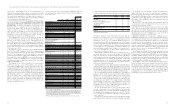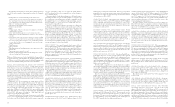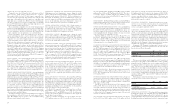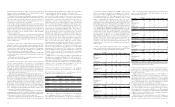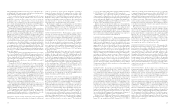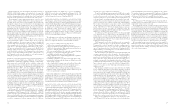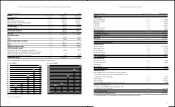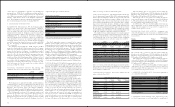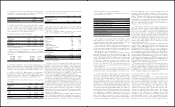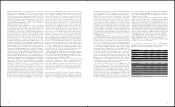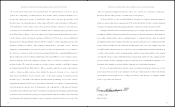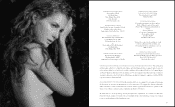Abercrombie & Fitch 2007 Annual Report Download - page 17
Download and view the complete annual report
Please find page 17 of the 2007 Abercrombie & Fitch annual report below. You can navigate through the pages in the report by either clicking on the pages listed below, or by using the keyword search tool below to find specific information within the annual report.
31
cash accounts for the Company’s Swiss and United Kingdom
operations in compliance with SFAS No. 52, “Foreign Currency
Translation”. Other operating income in Fiscal 2006 also included
non-recurring benefits from insurance reimbursements received
for fire and Hurricane Katrina damage.
CATALOGUE AND ADVERTISING COSTS Catalogue costs
consist primarily of catalogue production and mailing costs and are
expensed as incurred as a component of “Stores and Distribution
Expense.” Advertising costs consist of in-store photographs and
advertising in selected national publications and billboards and
are expensed as part of “Marketing, General and Administrative
Expense” when the photographs or publications first appear.
Catalogue and advertising costs, including photo shoot costs,
amounted to $32.8 million in Fiscal 2007, $39.3 million in Fiscal
2006 and $36.8 million in Fiscal 2005.
LEASES The Company leases property for its stores under operat-
ing leases. Most lease agreements contain construction allowances,
rent escalation clauses and/or contingent rent provisions.
For construction allowances, the Company records a deferred
lease credit on the Consolidated Balance Sheets and amortiz-
es the deferred lease credit as a reduction of rent expense on
the Consolidated Statements of Net Income and Comprehensive
Income over the terms of the leases. For scheduled rent escalation
clauses during the lease terms, the Company records minimum
rental expenses on a straight-line basis over the terms of the leases
on the Consolidated Statements of Net Income and Comprehensive
Income. The term of the lease over which the Company amor-
tizes construction allowances and minimum rental expenses on a
straight-line basis begins on the date of initial possession, which is
generally when the Company enters the space and begins to make
improvements in preparation for intended use.
Certain leases provide for contingent rents, which are deter-
mined as a percentage of gross sales in excess of specified levels. The
Company records a contingent rent liability in accrued expenses on
the Consolidated Balance Sheets and the corresponding rent expense
on the Consolidated Statements of Net Income and Comprehensive
Income when management determines that achieving the specified
levels during the fiscal year is probable.
STORE PRE-OPENING EXPENSES Pre-opening expenses
related to new store openings are charged to operations as incurred.
DESIGN AND DEVELOPMENT COSTS Costs to design and
develop the Company’s merchandise are expensed as incurred and
are reflected as a component of “Marketing, General and Admin-
istrative Expense.”
FAIR VALUE OF ASSETS AND LIABILITIES The recorded
values of current assets and current liabilities, including receivables,
marketable securities, other assets and accounts payable, approximate
fair value due to the short maturity and because the average interest
rate approximates current market origination rates.
NET INCOME PER SHARE Net income per share is computed
in accordance with SFAS No. 128, “Earnings Per Share.” Net income
per basic share is computed based on the weighted-average number
of outstanding shares of Common Stock. Net income per diluted
share includes the weighted-average effect of dilutive stock options
and restricted stock units.
Weighted–Average Shares Outstanding (in thousands):
2007 2006 2005
Shares of Class A Common Stock issued 103,300 103,300 103,300
Treasury shares oustanding (16,052) (15,248) (16,139)
Basic shares outstanding 87,248 88,052 87,161
Dilutive effect of stock options
and restricted stock units 4,275 3,958 4,060
Diluted shares outstanding 91,523 92,010 91,221
Stock options to purchase approximately 0.4 million, 0.1 million
and 0.2 million shares of Common Stock were outstanding for Fiscal
2007, Fiscal 2006 and Fiscal 2005, respectively, but were not included
in the computation of net income per diluted share because the impact
of such stock options would be anti-dilutive.
SHARE-BASED COMPENSATION See Note 4, “Share-Based
Compensation”.
USE OF ESTIMATES IN THE PREPARATION OF
FINANCIAL STATEMENTS The preparation of financial
statements in accordance with GAAP requires management to
make estimates and assumptions that affect the reported amounts
of assets and liabilities as of the date of the financial statements and
the reported amounts of revenues and expenses during the report-
ing period. Since actual results may differ from those estimates, the
Company revises its estimates and assumptions as new information
becomes available.
3. RECENTLY ISSUED ACCOUNTING PRONOUNCEMENTS
In September 2006, the FASB released SFAS No. 157, “Fair Value
Measurements” (“SFAS 157”). SFAS 157 establishes a common
definition for fair value under GAAP and also establishes a frame-
work for measuring fair value and expands disclosure require-
ments about such fair value measurements. In February 2008, the
FASB issued FASB Staff Position (“FSP”) 157-1 that eliminates SFAS
No. 13, “Accounting for Leases”, from the scope of SFAS 157. In
February 2008, the FASB issued FSP 157-2 that partially defers
the effective date of SFAS No. 157 for one year for non-financial
assets and liabilities that are recognized or disclosed at fair value in
the financial statements on a non-recurring basis. Consequently,
SFAS No. 157 was effective for the Company on February 3, 2008,
for financial assets and liabilities carried at fair value and non-
financial assets and liabilities that are recognized or disclosed at
fair value on a recurring basis and will be effective on February 1,
2009, for non-recurring non-financial assets and liabilities that are
recognized or disclosed at fair value. The Company is currently
evaluating the potential impact of adopting SFAS No. 157 and the
related FSPs on the consolidated results of operations and consoli-
dated financial condition.
In February 2007, the FASB released SFAS No. 159, “The Fair Value
Option for Financial Assets and Financial Liabilities – Including an
amendment of FASB Statement No. 115” (“SFAS 159”). SFAS 159
permits companies to measure many financial instruments and
30
No other valuation allowances have been provided for deferred tax
assets. The effective tax rate utilized by the Company reflects man-
agement’s judgment of expected tax liabilities within the various tax
jurisdictions.
The provision for income taxes is based on the current estimate
of the annual effective tax rate adjusted to reflect the tax impact of
items discrete to the quarter. The Company records tax expense
or benefit that does not relate to ordinary income in the current
fiscal year discretely in the period in which it occurs pursuant
to the requirements of APB Opinion No. 28, “Interim Financial
Reporting” and FIN 18, “Accounting for Income Taxes in Interim
Periods – an Interpretation of APB Opinion No. 28.” Examples
of such types of discrete items include, but are not limited to,
changes in estimates of the outcome of tax matters related to prior
years, provision-to-return adjustments, tax-exempt income and the
settlement of tax audits.
See Note 10, “Income Taxes” for discussion regarding the Company’s
policies for FIN 48.
FOREIGN CURRENCY TRANSLATION The majority of
the Company’s international operations use local currencies as the
functional currency. In accordance with SFAS No. 52, “Foreign
Currency Translation”, assets and liabilities denominated in for-
eign currencies were translated into U.S. dollars (the reporting
currency) at the exchange rate prevailing at the balance sheet
date. Equity accounts denominated in foreign currencies were
translated into U.S. dollars at historical exchange rates. Revenues
and expenses denominated in foreign currencies were translated
into U.S. dollars at the monthly average exchange rate for the
period. Gains and losses resulting from foreign currency transac-
tions are included in the results of operations; whereas, related
translation adjustments are reported as an element of other com-
prehensive income in accordance with SFAS No. 130, “Reporting
Comprehensive Income”.
CONTINGENCIES In the normal course of business, the
Company must make continuing estimates of potential future legal
obligations and liabilities, which require management’s judgment
on the outcome of various issues. Management may also use outside
legal advice to assist in the estimating process. However, the ultimate
outcome of various legal issues could be different than management
estimates, and adjustments may be required.
SHAREHOLDERS’ EQUITY At February 2, 2008 and
February 3, 2007, there were 150 million shares of A&F’s $.01
par value Class A Common Stock authorized, of which 86.2
million and 88.3 million shares were outstanding at February 2,
2008 and February 3, 2007, respectively, and 106.4 million shares
of $.01 par value Class B Common Stock authorized, none of
which were outstanding at February 2, 2008 or February 3, 2007.
In addition, 15 million shares of A&F’s $.01 par value Preferred
Stock were authorized, none of which have been issued. See Note
14, “Preferred Stock Purchase Rights” for information about
Preferred Stock Purchase Rights.
Holders of Class A Common Stock generally have identical rights
to holders of Class B Common Stock, except that holders of Class A
Common Stock are entitled to one vote per share while holders of
Class B Common Stock are entitled to three votes per share on all
matters submitted to a vote of shareholders.
REVENUE RECOGNITION The Company recognizes retail
sales at the time the customer takes possession of the merchandise.
Direct-to-consumer sales are recorded upon customer receipt of
merchandise. Amounts relating to shipping and handling billed
to customers in a sale transaction are classified as revenue and the
related direct shipping and handling costs are classified as stores
and distribution expense. Associate discounts are classified as a
reduction of revenue. The Company reserves for sales returns
through estimates based on historical experience and various
other assumptions that management believes to be reasonable.
The sales return reserve was $10.7 million, $8.9 million and $8.2
million at February 2, 2008, February 3, 2007 and January 28,
2006, respectively.
The Company’s gift cards do not expire or lose value over
periods of inactivity. The Company accounts for gift cards by
recognizing a liability at the time a gift card is sold. The liability
remains on the Company’s books until the earlier of redemption
(recognized as revenue) or when the Company determines the
likelihood of redemption is remote (recognized as other operat-
ing income). The Company determines the probability of the gift
card being redeemed to be remote based on historical redemption
patterns, and recognizes the remaining balance as other operating
income. At February 2, 2008 and February 3, 2007, the gift card
liability on the Company’s Consolidated Balance Sheets was $68.8
million and $65.0 million, respectively.
The Company is not required by law to escheat the value of unre-
deemed gift cards to the states in which it operates. During Fiscal
2007, Fiscal 2006 and Fiscal 2005, the Company recognized other
operating income for adjustments to the gift card liability of $10.9
million, $5.2 million and $2.4 million, respectively.
The Company does not include tax amounts collected as part of the
sales transaction in its net sales results.
COST OF GOODS SOLD Cost of goods sold primarily includes the
following: cost of merchandise, markdowns, inventory shrink, valuation
reserves and freight expenses.
STORES AND DISTRIBUTION EXPENSE Stores and distribu-
tion expense includes store payroll, store management, rent, utilities
and other landlord expenses, depreciation and amortization, repairs
and maintenance and other store support functions, as well as direct-
to-consumer and Distribution Center (“DC”) expenses.
MARKETING, GENERAL & ADMINISTRATIVE EXPENSE
Marketing, general and administrative expense includes photography
and media ads, store marketing, home office payroll, except for those
departments included in stores and distribution expense, information
technology, outside services such as legal and consulting, relocation
expenses, as well as recruiting, samples and travel expenses.
OTHER OPERATING INCOME, NET Other operating
income primarily consists of gift card balances whose likelihood
of redemption has been determined to be remote and are therefore
recognized as income and gains and losses on foreign currency
transactions and foreign currency gains and losses resulting from
remeasurement of foreign inter-company loans and foreign held



